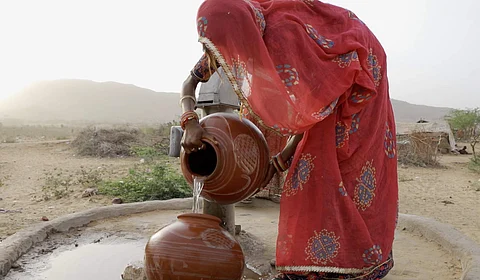

If you are thirsty and all you need to do to quench that thirst is reach out for a glass of water without thinking about contamination, you should be grateful. For those who aren't, Saaf Water has a solution.
The hardware device we are referring to can be installed near a pump and is compatible with community standards. This low-powered and cellular-enabled device monitors total dissolved solids (TDS), pH value, turbidity (cloudiness in a liquid caused by individual particles invisible to the naked eye), temperature and electrical conductivity. This information is relayed back to an on-site visual indicator and the Saaf Water Dashboard. And the way the information is presented is worth taking note of as simple colour indicators (red for contaminated, green for safe and so on) along with easy-to-understand graphs are employed. Add to this the work that their Machine Learning model performs. It recommends purification methods along with displaying an interactive map that helps them understand the water quality of their neighbours as well. It is these smart solutions that enabled them to win IBM’s Annual Call for Code Global Challenge 2021, as per the announcement that was made on November 18.
Developed by Hrishikesh M Bhandari, Goa; Satyam Prakash, New Delhi; Jay Aherkar, Pune; Manikanta Chavvakula, Hyderabad and Sanket Marathe, Goa, who met via IIT Madras' virtual BSc programme, they were prompted by what Hrishikesh's mother had to go through when she drank water that turned out to be contaminated while there were in Yellapur, a small town in Karnataka, in December 2020. "Her skin developed a rare condition and she had to be hospitalised for three months," shares Hrishikesh (20). That's when they started pondering over the magnitude of the problem. A United Nations report stated a statistic that was particularly shocking, that one out of every three people globally lacked access to safe drinking water. "We started understanding how access to safe drinking water is a global challenge and it is the need of the hour to work on a solution that will help. Only with the help of open source platforms and the community could we make this happen," shares Satyam (21).
The process of collecting estimates using the ML model and relaying the information back via the dashboard is accomplished within seconds and facilitated by IBM Cloud and IBM Cloudant NoSQL database. "We used the parameters provided by WHO (World Health Organization) to classify between what's contaminated water and what's not. Detecting if the water is biologically polluted would require onsite or perhaps a lab test and subject matter expertise as well. But our ML model understands patterns over a period of time and informs the user accordingly," explains Satyam regarding how the device can help cut down processes. Currently, the device is installed in Panaji, Goa. A community outreach programme brought to their notice the fact that the people might not know how to treat contaminated water — if RO purifier would suffice or would it take UV purification? That's why the dashboard informs the user about the methods needed to purify the water. And if the end-user doesn't have access to the internet, that's fine too, because the information is sent via an SMS as well. Currently, the information is given in Hindi and they are working on other languages as well.
"Our entire system is a simple plug-and-play one. All the user needs to do is install the device, which uses a 2G network, connect it to the network with a click of a button and that's it," informs Hrishikesh. Now that they have won IBM’s Annual Call for Code Global Challenge 2021, there are many developers who are keen to work with them and they hope that they will be able to make the most of it. The victory comes with a USD 200,000 award, open source support from the Linux Foundation and Call for Code ecosystem's deployment support as well.
